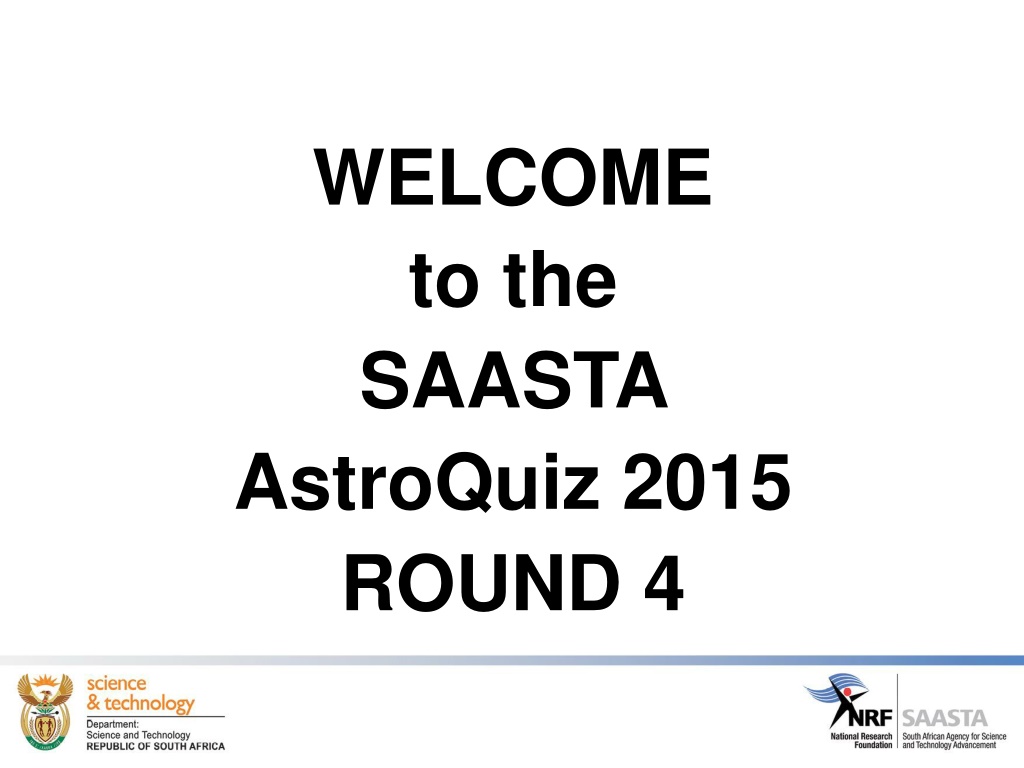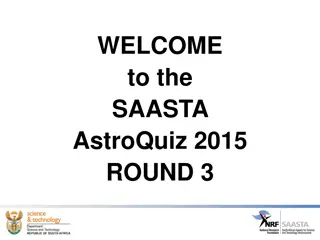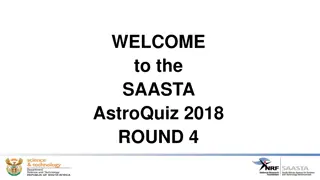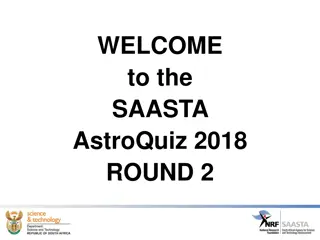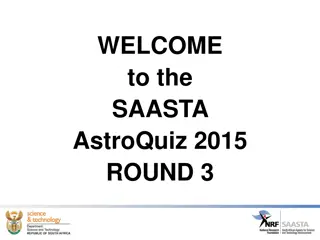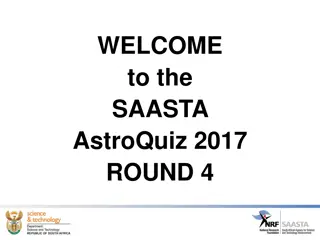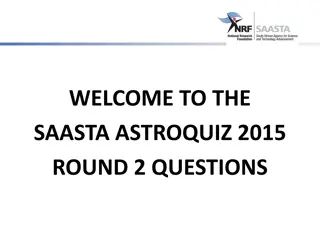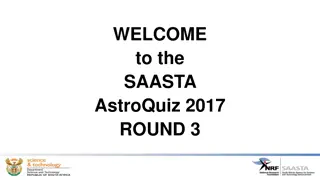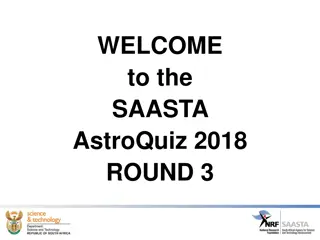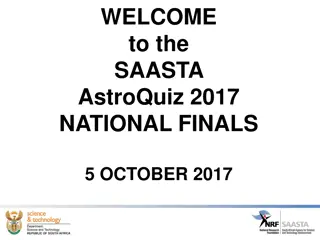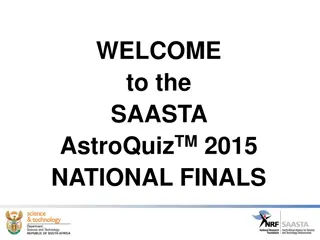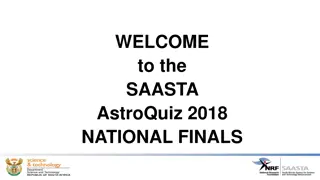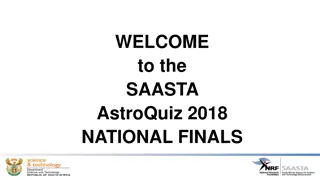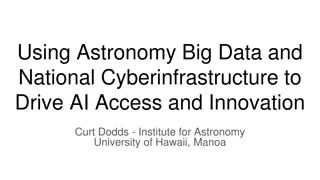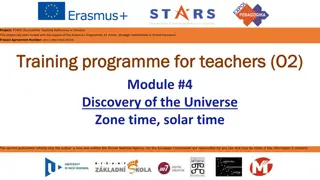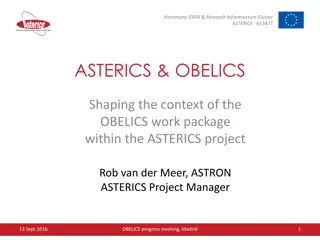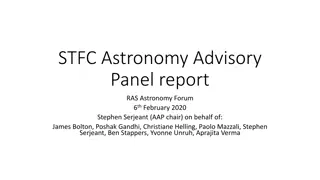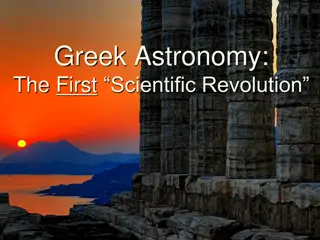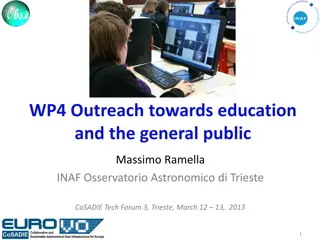SAASTA AstroQuiz 2015 Round 4: Test Your Astronomy Knowledge!
Test your astronomy knowledge with this engaging quiz featuring questions about eclipses, the Moon, Jupiter's Great Red Spot, tides, light speed, and celestial bodies' distances. Challenge yourself and learn more about the wonders of the universe!
Download Presentation

Please find below an Image/Link to download the presentation.
The content on the website is provided AS IS for your information and personal use only. It may not be sold, licensed, or shared on other websites without obtaining consent from the author. Download presentation by click this link. If you encounter any issues during the download, it is possible that the publisher has removed the file from their server.
E N D
Presentation Transcript
WELCOME to the SAASTA AstroQuiz 2015 ROUND 4
QUESTION 1 What is the meaning of the term umbra ? A. The Earth B. The Moon C. Shadow D. Eclipse
QUESTION 2 Unlike a solar eclipse, which can only be viewed from a relatively small area of the Earth, a lunar eclipse may be viewed from anywhere on the night side of the Earth. A. True B. False
QUESTION 3 A solar eclipse occurs during the day whilst a lunar eclipse occurs only at night. A. True B. False
QUESTION 4 The Great Red Spot on Jupiter is a giant __and exists as a result of ___ A. Crater; collision of gas molecules B. Storm; Swirling of gases C. Ocean; large amounts of water coming together D. Volcano; eruptions on the planet
QUESTION 5 The phase of the Moon that one sees depends on _______ A. The Moon s position and where you are on Earth's surface. B. How much of the sunlit side of the Moon faces Earth. C. How much of the Moon's surface is lit by the sun. D. Whether or not an eclipse is occurring
QUESTION 6 When do we experience the highest tides? A. During the Moon's first quarter phase B. When the Sun, Earth and Moon are nearly in a line C. During the Moon's third quarter D. When the Moon is at a right angle to the Sun
QUESTION 7 How long does it take light to travel from the Sun to the Earth? A. 1 minute B. 8 minutes C. 1 hour D. 24 hours
QUESTION 8 Arrange the following in terms of decreasing distance from Earth. A. Makemake, Eris, Ceres, Pluto B. Eris, Pluto, Ceres, Makemake C. Ceres, Makemake, Eris, Pluto D. Ceres, Pluto, Makemake, Eris
QUESTION 9 The orbits of all the known planets are roughly on the same plane? A. True B. False
QUESTION 10 Which statement describes the atmosphere of the planet correctly? A. Venus atmosphere contains mostly carbon dioxide B. Mercury s atmosphere contains mostly nitrogen C. Earth s atmosphere contains mostly oxygen D. Saturn s atmosphere contains mostly helium
QUESTION 11 The three most abundant gases found in Uranus' atmosphere are __ A. Hydrogen, Helium & Nitrogen B. Hydrogen, Helium & Methane C. Hydrogen, Helium & Ammonia D. Hydrogen, Helium & Oxygen
QUESTION 12 Saturn s rings are so spectacular that they span up to approximately three quarters the distance between Earth and its Moon. A. True B. False
QUESTION 13 What is the approximate average distance between the Moon and the Earth? A. 2,80 x 105 km B. 280 x 105 km C. 3,80 x 105 km D. 380 x 105km
QUESTION 14 Approximately how far do the rings of Saturn spread/span? A. B. C. D. 280 000 m 380 000 km 282 000 km 190 000 m
QUESTION 15 Which of the following statements about Saturn is false? A. Its rings orbit at different speeds around the planet B. There are gaps in the rings through which some of its moons orbit C. The rings can be seen with the naked eye on a very dark night D. The rings are so thin that their height is in the range of approximately 1 km or less
QUESTION 16 Which Kuiper Belt object was passed by a spacecraft this year? A. Mercury B. Pluto C. Neptune D. Eris
QUESTION 17 Which of the following statements is incorrect about the Kuiper belt? A. It is found between Mars & Jupiter B. It is found beyond Neptune C. It is where most dwarf planets are found D. It surrounds our star, the Sun
QUESTION 18 Which of the following is not true about the Moon? A. It has an effect on Earth s oceanic tides B. It has an effect on the Earth s rotation C. It has very thin and weak atmosphere D. It has very faint rings around it
QUESTION 19 If Proxima Centauri is approximately 4,22 light years away from the Earth. How far is it in km given that 1 light year = 9,46 x 1012km? A. 39,92 x 1013 B. 3,992 x 1013 C. 2,241 x 1013 D. 2,241 x 1012
QUESTION 20 What is the distance in kilometres travelled by light in one year? A. 1,50 x 108 B. 3,99 x 1012 C. 9,46 x 1012 D. 1,50 x 1012
QUESTION 21 At what speed does light travel in vacuum? A. 3,99 x 1012m/s B. 3,99 x 1012 km/h C. 2,99 x108 m/s D. 2,99 x108km/h
QUESTION 22 Which two observatories led to the formation of the SAAO in Cape Town? A. Republic & Royal B. Republic & Radcliffe C. Royal & Radcliffe D. Radcliffe & Natal
QUESTION 23 At which observatory was the discovery of Proxima Centauri made? A. Boyden Observatory B. South African Astronomical Observatory C. SAASTA Johannesburg Observatory D. Hartebeesthoek Radio Astronomy Observatory
QUESTION 24 In which year was the Southern African Large Telescope (SALT) opened? A. B. C. D. 1995 1994 2004 2005
QUESTION 25 Which astronomer was the first to classify stars systematically? A. Henrietta Swan Leavitt B. Cecilia Payne-Gaposchkin C. Annie Jump Cannon D. Carolyn Shoemaker
QUESTION 26 Which astronomer is an expert on the formation of high-mass stars? A. Dr Patricia Whitelock B. Dr Sharmila Goedhart C. Dr Claire Flanagan D. Dr Catherine Cress
QUESTION 27 Arrange the following in terms of increasing Earth year length. A. Mars, Jupiter, Uranus, Saturn B. Mars, Saturn, Uranus, Jupiter C. Mars, Jupiter, Saturn, Uranus D. Jupiter, Saturn, Uranus, Mars
QUESTION 28 Arrange the following in terms of an increasing number of satellites. A. Neptune, Mars, Uranus B. Uranus, Mars, Neptune C. Mars, Neptune, Uranus D. Mars, Uranus, Neptune
QUESTION 29 Arrange the following in terms of increasing distance from the Earth. A. Moon, Sun, Sirius, Proxima Centauri B. Sun, Moon, Sirius, Proxima Centauri C. Moon, Sun, Sirius, Proxima Centauri D. Moon, Sun, Proxima Centauri, Sirius
QUESTION 30 Which of the following is a criterion used for defining a dwarf planet? A. It is a very small celestial body, smaller than all known planets B. It has no satellites of its own C. It has not cleared its orbit of other celestial bodies D. It is very far from all other known planets but still orbits the Sun
THANK YOU FOR PARTICIPATING
SUDDEN DEATH TIE BREAKERS
QUESTION 1 The tilt of the Earth s spin axis causes ______ A. the seasons B. day and night. C. the ice on its poles. D. it to sustain life.
QUESTION 2 What keep planets in orbit around the Sun and moons in orbit around planets? A. Only gravitation forces B. Only the orbiting speeds C. Gravitation and orbiting speeds D. Only the Sun s attraction
QUESTION 3 Which of the following is the most accurate about seasons? A. Seasons occur because the Sun goes around the Earth and the Moon around the Earth B. Seasons occur because the Earth goes around the Sun C. Seasons occur because the Earth goes around the Sun and its axis is tilted at 23.50to the plane of its orbit D. Seasons occur because the Earth s orbit brings it nearer and further away from the Sun
QUESTION 4 Which one of the following is true? A. A galaxy is made of a few collection of stars held together by common gravity B. None of the stars in a galaxy have common gravity C. Galaxies contain stars only D. A galaxy is a collection of many stars, gas and dust which are held together by gravity
QUESTION 5 Planets in the solar system shine by ____ A. Nuclear fusion in their cores B. Refracting sunlight C. Reflecting sunlight D. b and c above
THANK YOU FOR PARTICIPATING ALL THE BEST!
